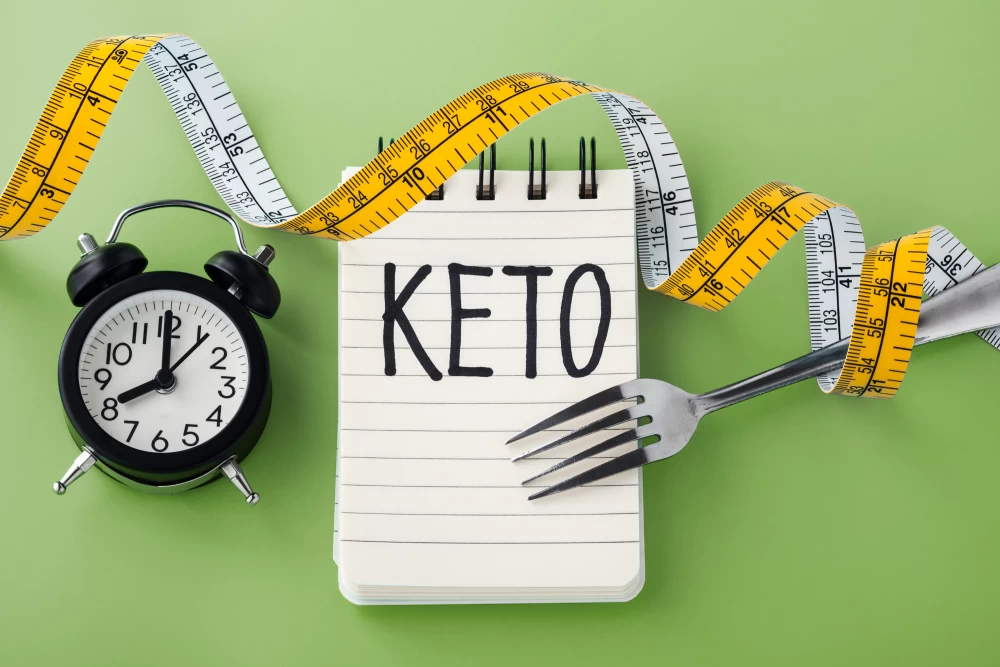
- 29th April 2023
Table of Contents
How does Intermittent Fasting work?
Intermittent fasting is a weight loss strategy that entails going without food for a set amount of time at regular intervals. The goal is to reduce calorie intake enough to create an energy deficit, resulting in weight loss. This eating plan has become popular in recent years as a replacement for standard diets based on calorie counting and portion control. The 16/8 method is one form of intermittent fasting in which the fasting period is 16 hours and the eating window is 8 hours. One day you eat normally, and the next day you drastically reduce your caloric intake; this is the alternate-day fasting method. The 5:2 diet is another option; on these days, you limit your caloric intake to 500–600 calories. Combining intermittent fasting with ketosis, a metabolic state in which fat is burned for energy instead of carbohydrates, can hasten weight loss. When glycogen stores are depleted, as they are when fasting or eating very few carbohydrates, the body enters a metabolic state known as ketosis. After that, the body stops using glucose from carbohydrates and starts using fat stores as fuel. Intermittent fasting has numerous health benefits, including increased fat burning, decreased inflammation, and enhanced cognitive performance.
Intermittent fasting's positive effects
Popular eating patterns include fasting for some time and then eating normally again. Weight loss, enhanced insulin sensitivity, and diminished inflammation are just some of the advantages of this eating pattern. Intermittent fasting's ability to induce ketosis, where fat is used as fuel instead of glucose, is a major perk. After fasting for 12-16 hours, ketosis sets in because glycogen stores have been depleted. When this happens, the liver breaks down fat stores into a substance called ketones, which the body and brain can use for fuel. Significant weight loss and enhanced metabolic health may result from this method. Intermittent fasting has many health benefits, including promoting fat burning and weight loss, improving brain function, and increasing longevity. By reducing inflammation, it may also reduce the risk of developing diabetes, cardiovascular disease, and cancer. Individuals may see significant improvements in overall health outcomes by incorporating intermittent fasting into their lifestyle habits with proper planning with their healthcare provider or dietician.
The Impact of Periodic Fasting on Ketosis

The idea that intermittent fasting can aid in weight loss and general health improvement has sparked widespread interest in the practise. The metabolic state of ketosis, in which fat is used for energy instead of carbohydrates, is one mechanism by which this can be achieved. This is because ketones are produced from fat stores as the body runs out of glucose (sugar) stored during a fast. Ketosis is a desirable metabolic state, but it should be noted that intermittent fasting does not ensure it. What you eat during your window of opportunity to eat is crucial. If you eat a lot of carbohydrates, your body will stop using ketones for energy and go back to using glucose. Furthermore, it may take longer for the body to enter ketosis if you are new to intermittent fasting or have been eating a high-carbohydrate diet for an extended period of time. While entering this fat-burning state, some people may experience symptoms such as headaches or fatigue. It is important to prioritise healthy food choices and speak with a healthcare professional before making any major dietary changes, including intermittent fasting, which can be an effective tool in assisting ketosis and weight loss efforts.
Ketosis and Its Impact on Weight Loss
When the body enters a metabolic state called ketosis, fat is used as an energy source rather than glucose from carbohydrates. This metabolic state is reached by the body after fasting for 12-16 hours on an intermittent fasting diet. Ketosis' benefit for weight loss is that it promotes the use of fat stores as energy, which in turn leads to less fat in the body. Ketones, produced by the liver during ketosis, provide the brain and muscles with an alternative energy source. Both blood sugar and insulin sensitivity are improved by this method. Individuals can lose weight and keep their muscle mass by following a ketogenic diet or engaging in intermittent fasting, both of which involve reducing carbohydrate consumption and increasing healthy fats. For those with preexisting health conditions like diabetes or liver disease, entering ketosis should be done gradually under medical supervision. Ketosis for weight loss has many advantages, but it isn't right for everyone and needs to be approached cautiously under medical supervision.

The Most Frequent Traps
Not getting enough calories during feeding periods is a common mistake people make when trying to intermittent fast and enter ketosis. Even if you reduce the number of meals you eat each day or the amount of carbohydrates you consume, your body will still require energy. Low calorie intake has been linked to a sluggish metabolism and increased fat storage. The other trap is dehydration. Drinking plenty of water throughout the day is essential when entering ketosis because the body loses more water and electrolytes than usual through urine. Headaches, fatigue, and other symptoms of dehydration can be a nuisance, especially if you're trying to lose weight. Finally, it's essential to pay attention to your body and make necessary adjustments. What works for one person may not work for another, as everyone has unique nutritional requirements. Talk to your doctor or a registered dietitian if you have any adverse reactions or aren't getting the results you expect from your current approach.
Suggestions for Achieving Ketosis Through Intermittent Fasting
Intermittent fasting combined with ketosis is a common strategy for reducing body fat and improving health. To be successful with this diet, however, careful thought and planning are required. Instead of diving headfirst into the process, ease into it gradually. This entails lowering the duration of your initial fast (say, from 24 to 12 hours) before moving on to longer and longer fasts (16-20 hours). A healthy, ketogenic diet that emphasises fats, proteins, and vegetables while cutting back on processed foods, sugars, and carbohydrates is essential for intermittent fasting and ketosis. It is also important to drink plenty of water or other low-calorie beverages every day. In addition to these dietary adjustments, a regular exercise routine is a great way to boost your metabolism and speed up the fat-burning process. Cardiovascular exercise and strength training for specific muscle groups are examples. Everyone has the potential for success with intermittent fasting and ketosis with the right amount of time, effort, and planning.
